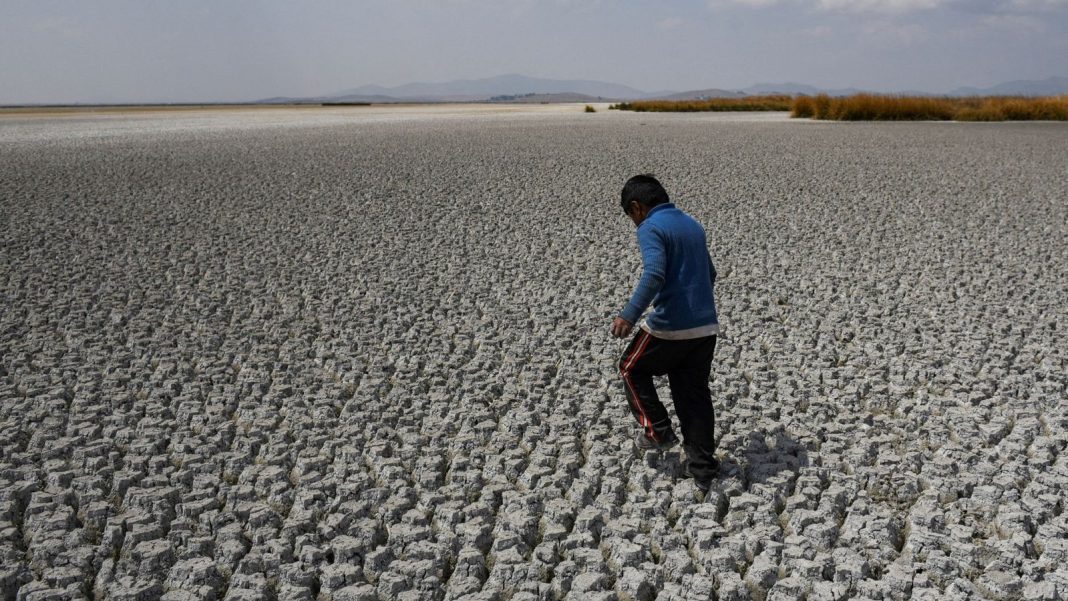Extreme weather has seen records broken and many lives lost or displaced in 2023.
Scientists believe preliminary figures show the past 12 months to be the hottest in 125,000 years.
Here’s a look at some of the year’s biggest weather-related events from across the globe.
January
In the US, the end of 2022 into the first weeks of 2023 saw at least 21 people killed in flooding, mudslides and power outages in California – a further 1,400 were rescued.
Iowa saw its first January tornadoes in more than 50 years, while around 50 million people were placed under alert as a winter storm slowly moved across the southern states.
January: Flooding and mudslides ushered in the new year in California. Pic: AP
This was despite, overall, the US experiencing its sixth warmest January on record.
The National Oceanic and Atmospheric Administration said the average temperature was 5.1F above average.
In New Zealand, four people died as torrential rain brought flash flooding and landslides to Auckland.
In Western Australia’s Kimberley region, Tropical Cyclone Ellie brought a year’s worth of rain in just a few days.
The “one-in-100-year” floods forced military aircraft to help residents evacuate their homes.
February
At the beginning of the month, Cyclone Freddy formed in the southern Indian Ocean near Australia and became one of the most long-lasting and deadly storms on record.
It would take until the middle of March before it finally dissipated, leaving behind a trail of destruction and breaking records for the number of times – seven – it re-intensified.
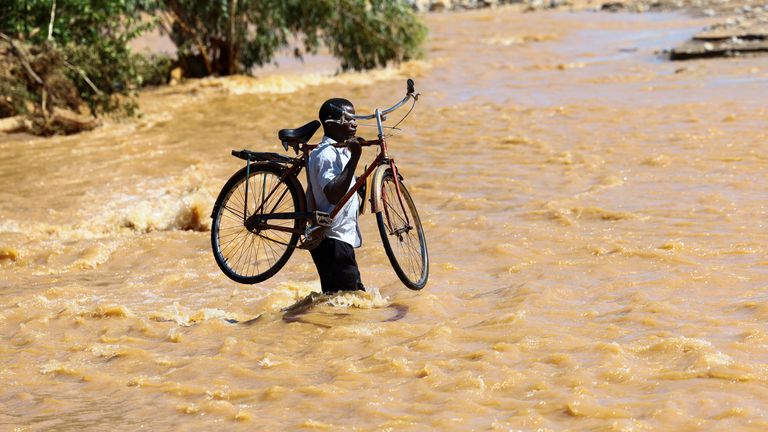
February/March: Cyclone Freddy brought severe flooding to Malawi
Officials believe it killed at least 1,400 people – including more than 1,200 in Malawi where intense rain brought destructive flash flooding.
Hundreds more people were left missing.
When it made landfall in Madagascar and Mozambique, authorities said it killed more than 200 people and damaged thousands of buildings, infrastructure and farmland.
The storm recorded more energy over its lifetime than a whole typical US hurricane season, meteorologists said.
March
Some parts of Spain experienced their driest March in 20 years, officially placing the country in long-term drought and increasing concerns about the nation’s water reserves.
Drinking water supplies fell to their lowest level since 1990, officials said.
Spain’s first major wildfire of the year forced hundreds of villagers to leave behind their animals as they fled their homes.
Torrential rain brought surging waters and flash flooding to Turkish provinces Adiyaman and Sanliurfa.
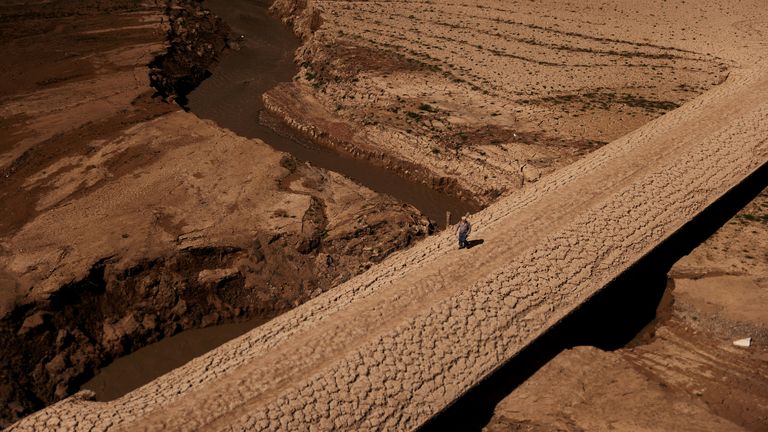
March: A man walks on the cracked ground of what is normally a reservoir in Catalonia, Spain

March: The power of Cyclone Freddy left a trail of destruction in Malawi and Mozambique. Pic: AP
Officials said 16 people were killed as roads were turned into rivers in the same southeastern region which had been hit by an earthquake just weeks earlier.
A container home providing accommodation for a group of earthquake survivors in Tut, a town in Adiyaman, was swept away, while two firefighters were reported missing and another six people died in floodwaters in Sanliurfa.
April
Many parts of Europe felt more like July as a heatwave gripped much of the continent and broke records.
A heat dome from northern Africa to the Iberian Peninsula saw the mercury climb to around 40C (104F) for millions of people – up to 20C higher than the average for the time of year.
Spain recorded its hottest ever April temperature, reaching 38.8C (101.84F), while the blistering heat also hit a record high in Portugal.
The extreme conditions followed the driest March in 20 years in Spain, officially placing the nation into long-term drought and prompting Prime Minister Pedro Sanchez to warn of the ongoing “challenge” posed by climate change.
Reservoirs were around 15% below average levels, with some shrinking to just 26% of capacity.
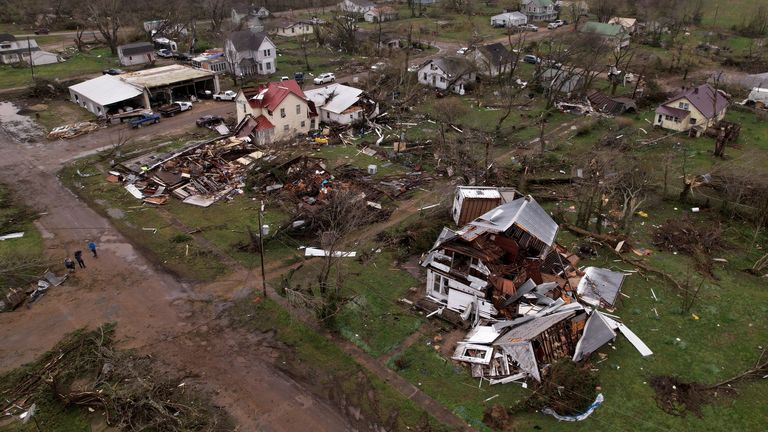
April: Damaged homes in the aftermath of tornadoes which swept through the US south and Midwest
At least 11 people were killed when tornadoes ploughed through the US south and Midwest.
One person died when the storms forced a theatre roof to collapse during a heavy metal gig in Belvidere, Illinois – leaving many others buried beneath rubble.
May
Hundreds of people were reported killed or missing as Cyclone Mocha made landfall in Myanmar and the coast of Bangladesh.
Myanmar’s meteorological department said it packed winds of around 130mph as it reached land – but it had also become one of the strongest storms on record when it intensified to 175mph as it headed across the Indian Ocean.
Officials in Myanmar, a country run by military leadership, said more than 450 people had been killed, but other reports put the figure nearer to 150.

May: A woman salvages belongings from her home, which was damaged by Cyclone Mocha in Bangladesh. Pic: AP
In Bangladesh, around 500,000 people fled coastal areas – while the UN said the severe conditions had put two million individuals at risk.
In the eastern Democratic Republic of Congo, more than 400 people were said to have been killed in flash floods in one of the country’s deadliest natural disasters.
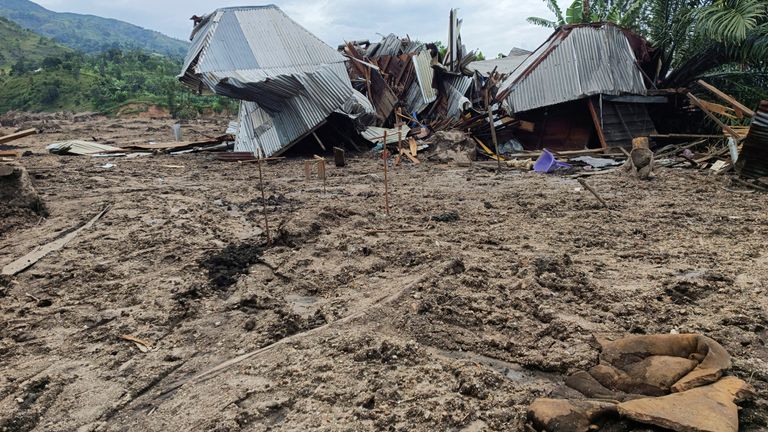
May: Communities were swept away by landslides in the Democratic Republic of Congo
Days of torrential rain triggered landslides and caused rivers to break their banks.
Speaking to the Reuters news agency, South Kivu governor Theo Ngwabidje Kasi said the number of deaths stood at 401 – but officials feared this was eventually much higher.
Flooding and landslides also killed at least 129 people in Rwanda and six in Uganda.
June
Fires which first started burning in April and May escalated further in June in what would become the worst wildfire season in Canadian history.
The previous record season was in 1989 when wildfires scorched 7.6 million hectares (18.8 million acres) – nearly the size of Scotland.
But in 2023, thousands of people were displaced and at least four firefighters died as the burning conditions swept across at least 18 million hectares (44.5 million acres) – an area comfortably bigger than England, Wales and Northern Ireland combined.
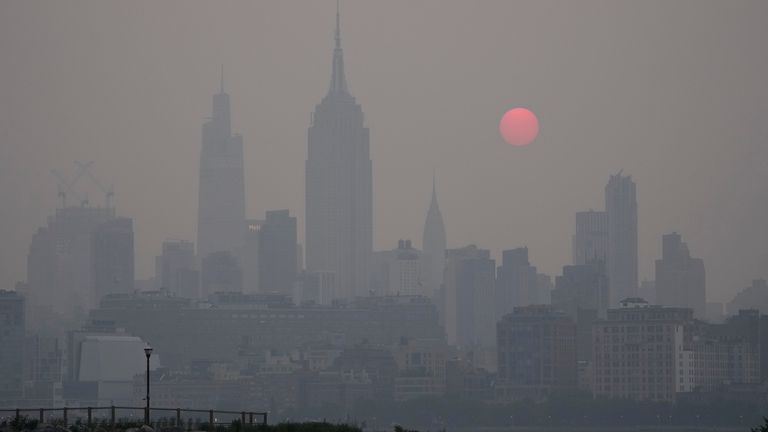
June: Smoke from wildfires in Canada drifted into the US, dramatically hitting the air quality in cities like New York. Pic: AP
With drier conditions than normal, smoke from Canadian fires drifted south into the US, forcing thousands of flights to be delayed and postponing baseball games.
Cities were left in a yellow-brown fog as forest fires in Canada saw 120,000 people flee their homes.
Most of Haiti was hit by heavy rain, strong winds, floods and landslides at the beginning of the month.
More than 40 people died, while nearly 6,500 had to leave their homes, according to the Haitian civil protection – but other sources said around 40,000 had been displaced due to the extreme conditions.
July
Temperatures consistently climbed above 40C across Europe as the month became the hottest on record.
The Copernicus Climate Change Service said the average world temperature was 16.95C (62.51F) across the month – beating the 2019 record of 16.63C (61.93F).
Antarctic sea ice also dropped to lows not seen since records began in 1979.
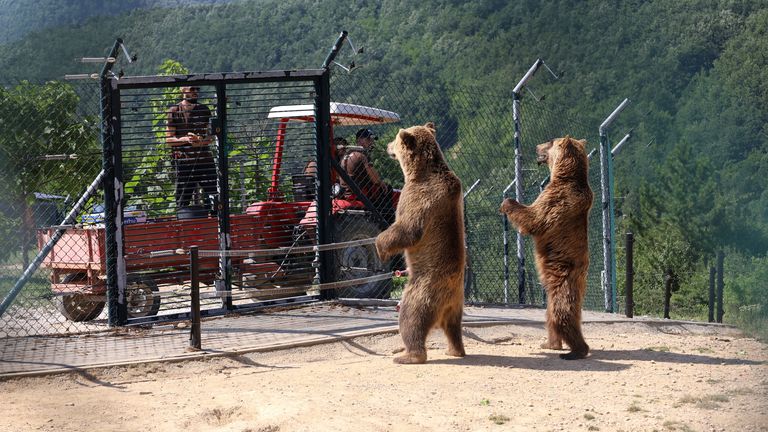
July: Two bears stand as workers prepare to throw food to them at a sanctuary in Kosovo as temperatures soar
July also saw the hottest three-week period ever recorded, the three hottest days on record, and the highest-ever ocean temperatures for the time of year.
The month became the hottest on record.
Southern Europe struggled with record high temperatures, while wildfires in Canada and Greece continued to impact the environment and people’s health.
The European Space Agency’s heat-sensing satellite Copernicus detected land surface temperatures had exceeded 45C (113F) across much of Italy.
On the slopes of Mount Etna, the volcano on Sicily, the earth temperature passed 50C (122F) on 9 and 10 July when readings were taken in the morning.
A southern Europe heatwave, named Ceberus, saw Spain, France, Greece, Turkey, Kosovo and Italy struggling in the intense conditions.
Spain flirted with temperatures of around 45C, while Sicily and Sardinia continued to experience figures approaching 50C.
Forest fires took hold across the continent, including in Turkey, Greece, Croatia, Portugal, Spain and Italy.

July: Wildfires threatened seaside communities in Greece
In Greece, evacuation orders were issued for at least six seaside communities. Hundreds of children were also evacuated from a summer camp west of Athens.
The European Forest Fire Information System said across the EU, more than 180,000 hectares (444,800 acres) of land – an area bigger than Greater London – had been scorched by the fires by the end of the third week of July.
In the Philippines, at least 27 people died when a boat overturned during a typhoon.
Record monsoon showers killed more than 100 people over two weeks in parts of northern India, including in Himachal Pradesh, which was the worst hit.
In neighbouring Myanmar, five people were killed and around 60,000 were displaced after heavy flooding caused by intense rain.
At least 33 people died and many others were trapped when monsoon rain continued into August, triggering floods and landslides in India’s Himalayan region.
Rainfall was “excessive” in Pakistan – the country’s meteorological service said it was 70% above average – with the authorities revealing at least 50 people had died in heavy monsoon rains.
July also saw the beginning of a lengthy heatwave in South America.
In what is normally the winter, temperatures climbed to above 40C in Brazil, Paraguay, Bolivia and Argentina and lingered into the spring.
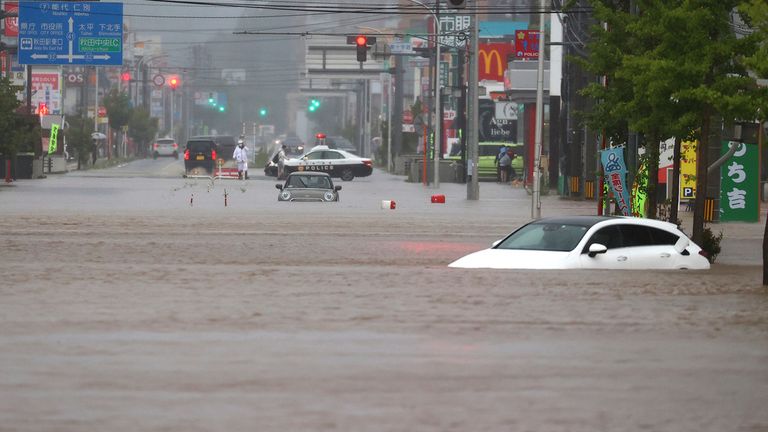
July: Flooding brought chaos to parts of Japan. Pic: AP
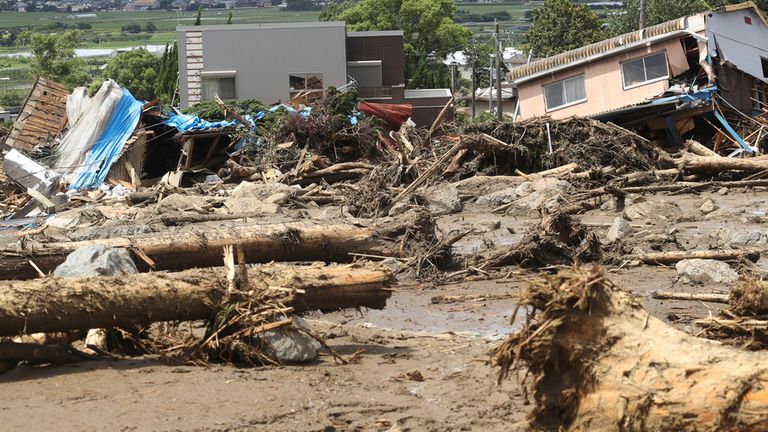
July: Buildings were swept away by floods and landslides in Japan. Pic: AP
In Japan, two people died and more were missing as tens of thousands of residents were urged to move out of areas in danger of landslides and flooding amid torrential rain.
In China, torrid heat gripped the country for several weeks – forcing local officials to ask residents and businesses to curb the usage of electricity.
Heavy rainstorms hit New York and Pennsylvania with the emergency services rescuing people stuck in vehicles along flooded roads.
A “dangerous” heatwave also affected up to 200 million people in the eastern United States.
In Phoenix, Arizona, the mercury climbed to above 43C (109.4F) for a record 31 consecutive days – while President Joe Biden said experts had revealed extreme heat was “already costing America $100bn a year”.
UN secretary general Antonio Guterres said: “The only surprise is the speed of the change.
“Climate change is here. It is terrifying. And it is just the beginning.”
August
Hundreds of people were reported missing as wildfires swept across Maui in Hawaii.
Maui county’s mayor, Richard Bissen, said the deadliest fires in US history had killed more than 100 people.
A total of 850 people were still missing following the fires in Maui, he said.
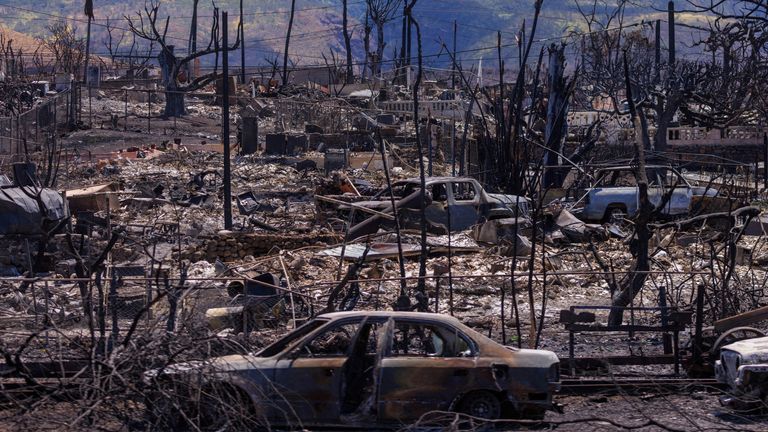
August: Hawaii experienced the deadliest wildfires in US history
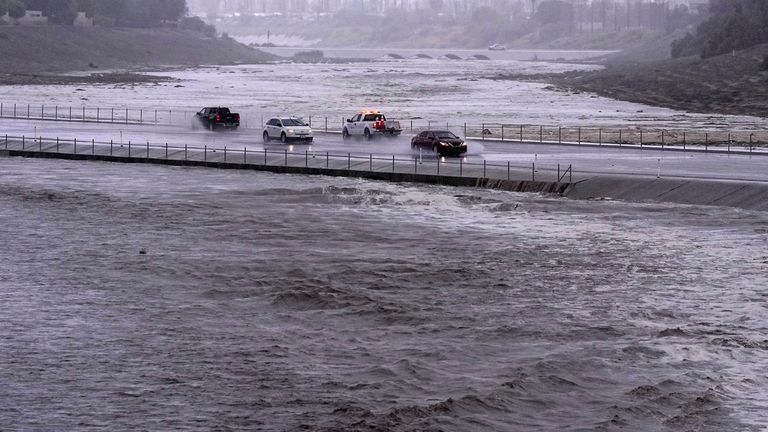
August: Vehicles struggle to make their way on one route in California as Storm Hilary grips the area. Pic: AP
Storm Hilary approached the Mexican coast before heading into the US and bringing California its first tropical storm in 84 years.
At least nine million people in southern California were warned of “life-threatening” rain, mudslides, tornadoes, high winds and power outages.
September
Mediterranean Storm Daniel caused catastrophic flooding – before engulfing entire neighbourhoods in Libya.
The storm began forming over the Ionian Sea on 4 September and after battering Bulgaria, Turkey and Greece, made its way south across the Mediterranean towards Africa.
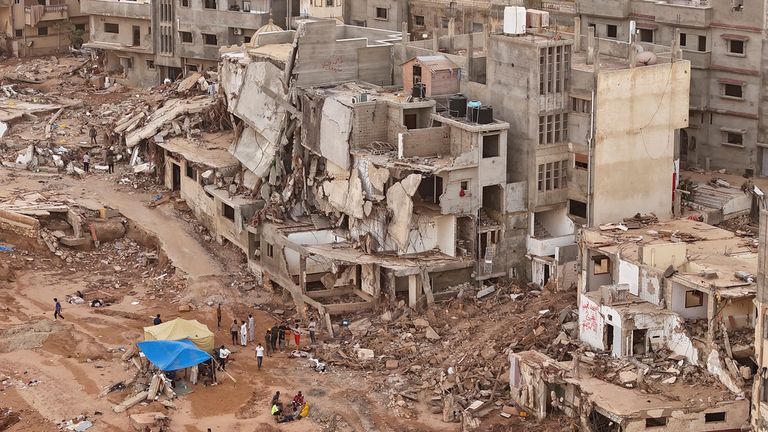
September: Rescuers search through the debris of collapsed buildings in Derna. Pic: AP
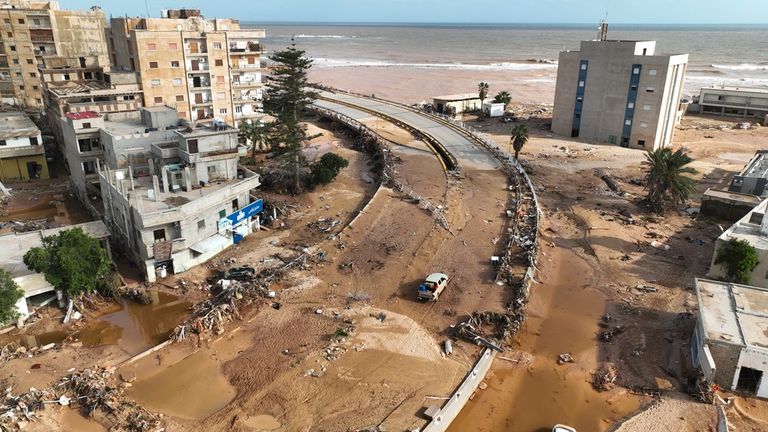
September: Thousands of people lost their lives in Derna, Libya. Pic: AP
Thousands were killed in Derna when a torrent of water caused buildings to collapse and swept away communities in the Libyan city.
Libya asked for international help, declaring the eastern Cyrenaica province a disaster area.
The number of deaths climbed to at least 11,300 in Derna, the Libyan Red Crescent said – but government officials said the final figure of those killed was above 20,000 and much of the city had been swept out to sea.
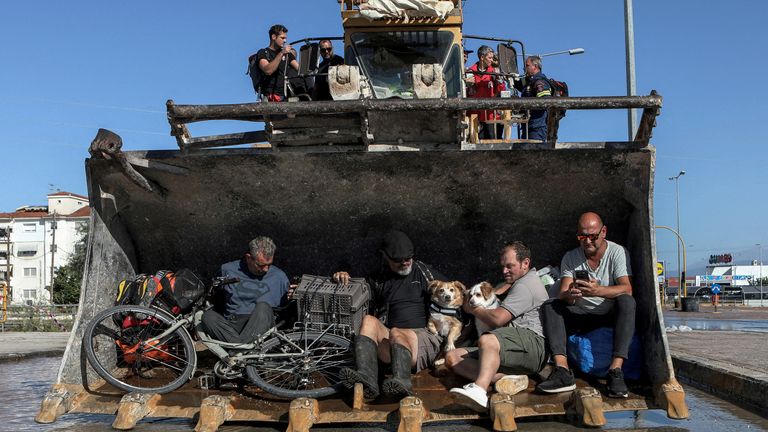
September: After a long heatwave, Storm Daniel brought more disruption to Greece
Many homes, businesses and roads were flooded in Greece – the storm dumped the equivalent of 18 months of rain on Thessaly in less than three days, devastating the agricultural region.
It was a dramatic end to one of Greece’s longest heatwaves in decades.
Three people were killed in Bulgaria when the storm caused a bridge to collapse, officials said.
October
Storm Babet brought extreme conditions, including torrential rain, to northern and western Europe.
In the UK, at least seven people were killed.
The government said reports of floods to the Environment Agency (EA) reached the highest level since 2015/16, with more than 300 flood warnings being issued.
Hundreds of people were left homeless with about 1,250 properties in England flooded, according to the EA.
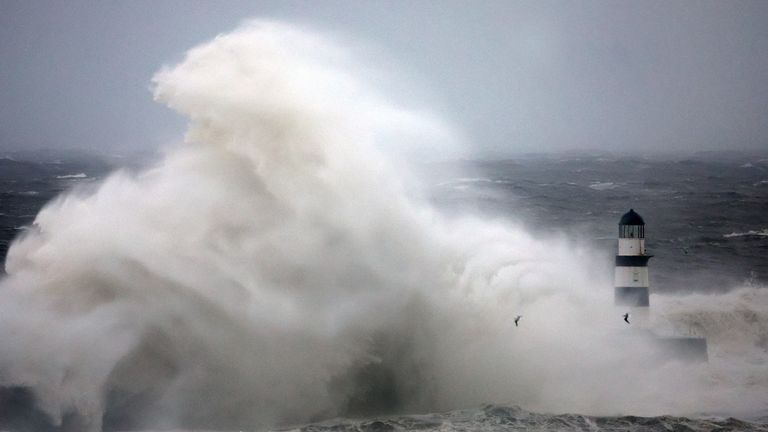
October: Many areas in the UK broke rainfall records when Storm Babet arrived
The Met Office said a total of 13 areas broke their daily rainfall records for October, including locations in Suffolk, South Yorkshire, Lincolnshire, Wiltshire, Kincardineshire, North Yorkshire, Nottinghamshire, Northumberland, Derbyshire and Humberside.
The storm brought chaos to other parts of Europe – killing one person in Germany, causing water surges not seen in more than 100 years in Denmark, damaged trees and homes in Norway, and caused the collapse of ceilings at a terminal building at Faro airport in Portugal.
Meanwhile, more than 100 dolphins and thousands of fish were found dead in the Brazilian Amazon amid the record-breaking high temperatures.
Experts said the temperature of the water in some parts of the Amazon reached a record 39C (102.2F) and believe the conditions are making it increasingly difficult for wildlife to survive.

October: Canoes on the riverbed in Brazil in a year which brought an historic drought to the Amazon
The Amazon drought shows the region is becoming drier, experts said – by the beginning of November, six out of 22 river monitoring stations had registered their lowest level on record, while just five were at normal levels.
In the city of Manaus, which was choked with smoke from wildfires, the Rio Negro – a tributary of the Amazon River – fell to its lowest level in 121 years.
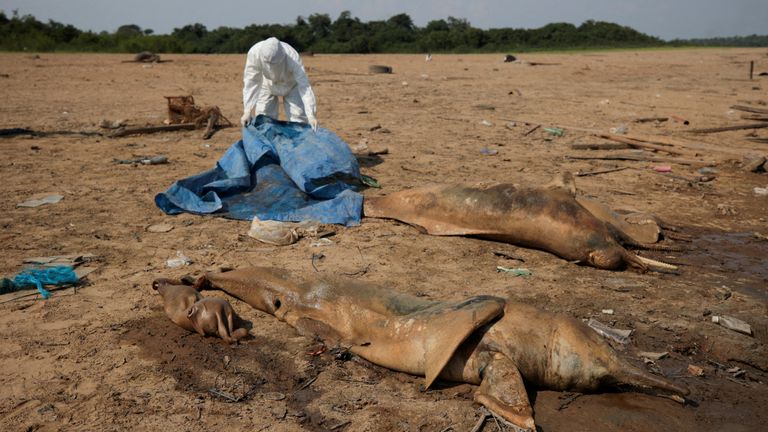
October: Dolphins were found dead in the Brazilian Amazon amid fears the changing conditions are making it more difficult for wildlife to survive
Experts continued to express concerns about the future of the Amazon, highlighting how it currently absorbs planet-heating carbon.
But if too many trees die and rot, it would become a net carbon emitter – accelerating climate change.
In Kenya, Somalia and Ethiopia, seasonal rains lead to severe flooding and landslides.
Hundreds of people are killed while hundreds of thousands are forced from their homes, according to officials.
Kenya’s meteorological department later warns the heavy rains will continue into the new year.
November
A second major storm in a month hits the UK along with the Channel Islands and parts of Europe – bringing 104mph winds, torrential rain and flooding.
The Met Office said Storm Ciaran in southern Britain was “comparable in severity” with the Great Storm of October 1987.
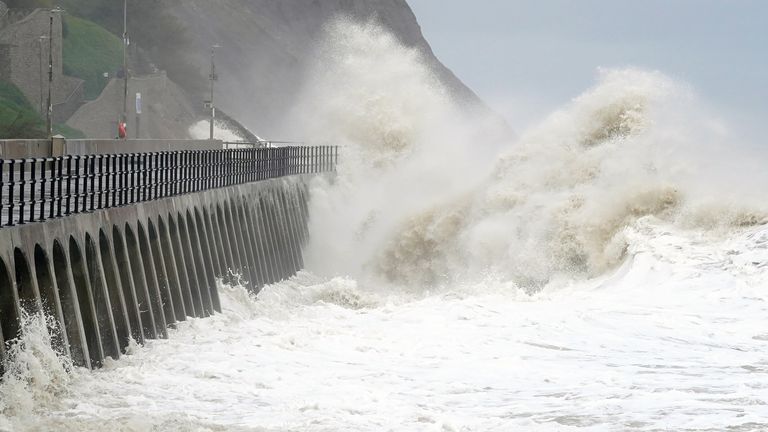
November: Waves crash over the promenade in Kent as Storm Ciaran brings high winds and heavy rain
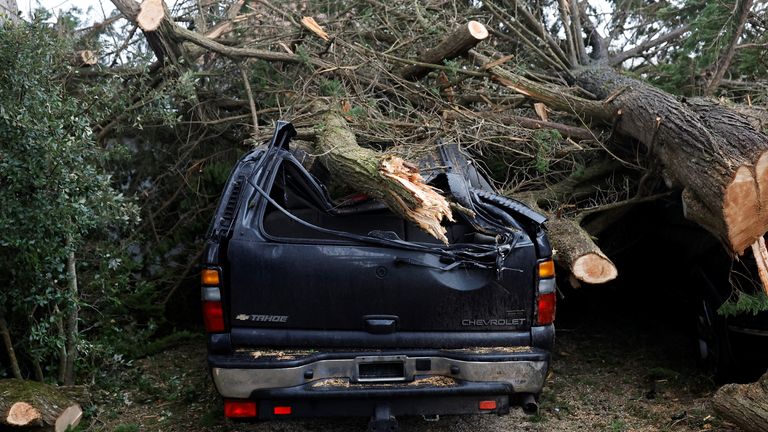
November: Storm Ciaran brought dangerous conditions to France and across Europe
A tornado in Jersey during the storm was likely to have been the strongest in the British Isles for almost 70 years, the Tornado And Storm Research Organisation said.
In northern France, a reported 1.2 million people were without power.
A Met Office analysis said at least 13 deaths were reported across Europe as the storm made its way into countries such as Germany, Italy and Belgium – other sources said the combined figure of those killed across the continent was above 20.

October and November: The horizon burns near Tenterfield amid a series of wildfires in western parts of Australia
In western Australia, the emergency services tackled bushfires amid a rare spring heatwave with temperatures reaching around 40C.
Ten homes were destroyed, residents were evacuated from some communities and a number of firefighters were hurt tackling fires in Perth.
In Brazil, Sao Paulo saw temperatures reach 37.7C (99.86F) – which meteorologists said was the highest figure for a November day in the city since 1943.
Most Brazilian states faced “great danger” from the ongoing heatwave which had stretched from the region’s winter into what is normally the spring, according to the National Institute Of Meteorology.
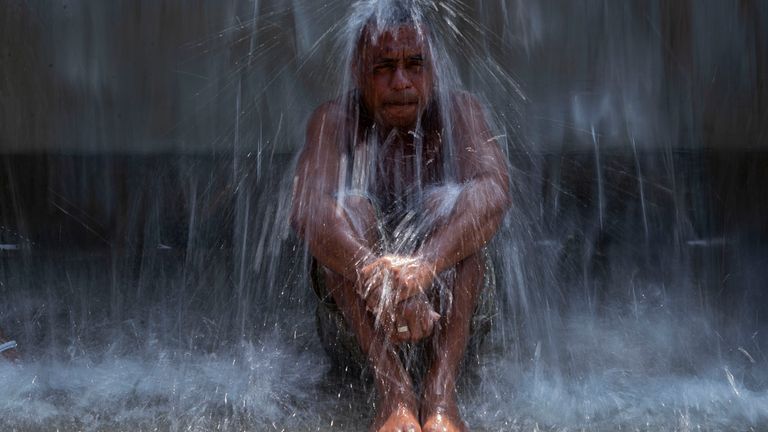
November: The soaring Brazilian heat forced people to find ways to cool down, including sitting in a water fountain. Pic: AP
The heat index – a combination of temperature and humidity – hit a record high of 58.5C (137.3F) in Rio de Janeiro.
Wildfires also burned in the Brazilian Pantanal – the world’s biggest tropical wetlands.
The fires ravaged an area about the size of Cyprus, or more than 947,000 hectares (2,340,000 acres).
December
Floods and landslides in northern Tanzania killed 47 people following torrential rain, said government officials.
Search and rescue operations took place in the Manyara region as the authorities feared some bodies might be trapped in the mud.
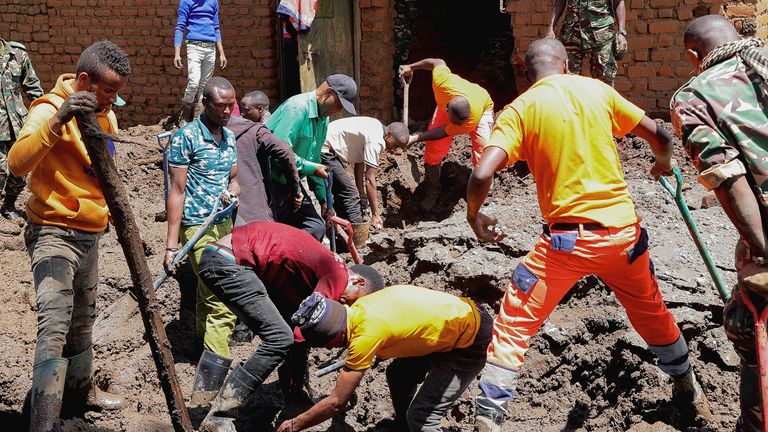
December: Rescuers search for the bodies of people killed in floods and landslides in Tanzania
The rains left a trail of destruction, damaging infrastructure and submerging towns in East Africa, displacing hundreds of thousands of people.
An atmospheric river brought heavy rain, flooding and warm winter temperatures to the Pacific Northwest.
Daily rainfall records were broken in Seattle after the city received 1.5 inches of rain.
A landslide closed parts of a Seattle trail popular with walkers, joggers and cyclists – while temperatures nearly reached 18C (64.4F) in Walla Walla, Washington.
Record-breaking heat hit parts of Australia.
The temperature reached 43.5C (110.3F) at Sydney Airport – the highest recorded at the same weather station since records began in 1929.
Another weather station in the city recorded temperatures of 38.9C (102F).
The temperature was almost 15 degrees above the average December high for Sydney.
Southern parts of the country then received more than two months of rainfall in less than 24 hours as the heat eased, meteorologists said.
A week later, more than 300 people were rescued from floods caused by heavy rain in northern Australia.
Several towns along the coast near the Great Barrier Reef were cut off by the conditions, which were linked to the former tropical cyclone Jasper.
Queensland state received around 24 inches of rain across 40 hours – more than triple the December average.
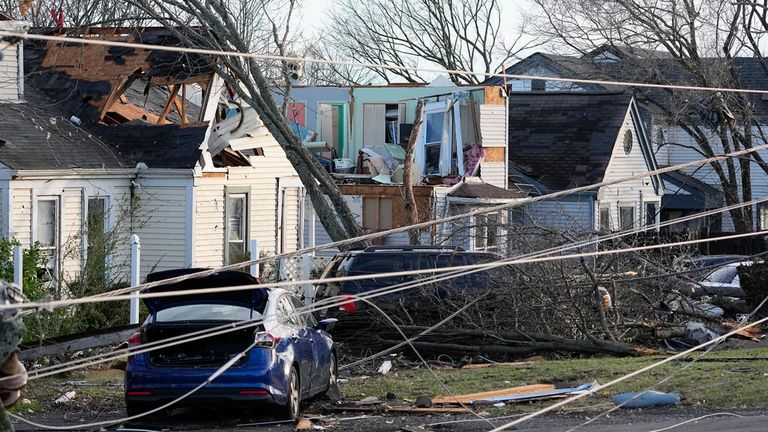
December: Storms swept across Tennessee, destroying homes and buildings. Pic: AP
At least six people died in storms and tornadoes across parts of the southern US state of Tennessee.
Spain experienced record heat for December with temperatures of 30C (86F) endangering the winter sports season.
“It’s one of the warmest masses of air to have ever overflown Spain at this point in December,” said Ruben del Campo of the national weather agency AEMET.
Meanwhile, back in the UK this week, a rare supercell thunderstorm hit parts of Greater Manchester, causing significant damage to about 100 homes.
Please use Chrome browser for a more accessible video player

0:43
Dramatic footage shows tornado damage
It’s also thought a second supercell thunderstorm struck Lancashire, causing hail, lightning and strong winds.
Supercell thunderstorms have a deep and persistently rotating current of air at their centre that can form a tornado in about 30% of supercell thunderstorms or less, according to the US National Weather Service.


